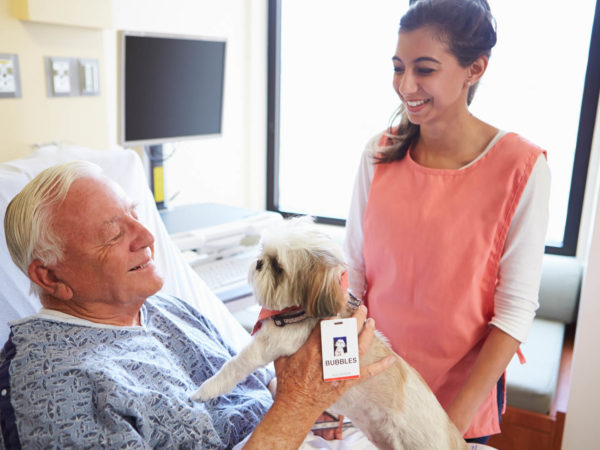Animal Assisted Therapy

What is animal assisted therapy?
Animal assisted therapy (AAT) uses trained animals to enhance an individual’s physical, emotional and social well-being, thus improving self-esteem, reducing anxiety and facilitating healing. The use of AAT reportedly dates back to the 1940s, when an army corporal brought his Yorkshire Terrier to a hospital to cheer wounded soldiers. There was such a positive response that the dog continued to comfort others for 12 more years. A wealth of information on AAT comes from Pet Partners (formerly Delta Society), a research-based organization committed to promoting animal-based treatments around the country. They distinguish animal-assisted activities (such as provided by seeing-eye dogs to the visually impaired) from therapy, in which the emphasis is on psychological support and physical healing.
What health conditions can animal assisted therapy help to treat?
Research has demonstrated that animals have a calming effect, reducing blood pressure and anxiety. They tend to make people less lonely and bring out positive social characteristics. Many hospitals and nursing homes use AAT programs to help reduce feelings of depression and isolation in their patients as well as stimulating mental activity through interaction with the animal. Because animals are non-judgmental, those with deformities or disfigurements may find it easier to socialize with them versus with other individuals. According to the Pet Partners, research in seniors has shown that those who own a dog have lower blood pressure and cholesterol levels than those who don’t. Animals can also be a pleasant distraction for those experiencing uncomfortable medical procedures.
Animal assisted activities (AAA) provide interactions in a number of different environments for the purpose of improving motivation, assisting educational activities, or just having fun to enhance quality of life. These primarily involve casual visitations by the animal, and are distinguished from AAT programs that target particular individuals or medical conditions.
Children are generally attracted to animals and can often express themselves better than with other children or adults. Dogs and cats are often used to calm children who have experienced physical or mental trauma. The setting may differ with special needs children, requiring more individualized attention and preparation.
What should one expect on a visit to a practitioner of AAT?
There are many different animals used in AAT, from dogs and cats to horses and even dolphins, each of which may require travel to the site where the animals are maintained. Therapy may also take place in an institution like a hospital, nursing home, school or library. There is typically no preparation needed for therapy when animals come to visit. In a hospital setting, volunteers will usually bring their animals at specific times, and patients are welcome to pet, talk to and interact with them.
Are there any side effects or indications where AAT should be avoided?
Safety is always a consideration when working with animals. It is important to ensure that the volunteer handler has done the necessary preparation to have his animal adequately trained. The animal should be up to date on all necessary vaccinations and should be in good health. Organizations providing AAT should be able to validate this information. Treatment using larger animals like horses and dolphins should only be done by certified therapists.
Some people are afraid of animals, particularly large ones. It is important to assess the willingness of the client to participate in AAT. A preliminary step often involves visiting the animal or therapeutic site to evaluate the potential relationship and interaction.
Allergies are another aspect to consider. Clearly, allergies to a particular animal could make therapy difficult, and would most likely be a reason not to use AAT if the response is severe enough to interfere with the interaction.
Those with severe mental health disorders should be closely monitored to ensure the safety of both animal and client.
Anyone with reduced immunity – individuals with active HIV/AIDS, cancer patients receiving chemotherapy or radiation, those on high-dose steroids and other immune-suppressive medications – should get clearance from their physician before participating in AAT.
Is there a governing body that oversees or credentials practitioners in AAT?
There is not a governing body overseeing AAT. Individual institutions generally have their own rules as to what animals they allow to visit their facilities, and documentation of health and current vaccination status is generally required. Organizations like Pet Partners offer courses to facilitate the training of animals and their human counterparts. Their website lists available courses and conferences around the country as well as the necessary qualifications to achieve to become an AAT instructor.
How does one get in touch with a practitioner of AAT?
Pet Partners is a good place to start. There is a tab on their home page that provides a directory search.
Are there other therapies that might work well in conjunction with AAT?
Typically, AAT has been used to promote socialization, provide distraction, enhance trust and improve overall well-being. It can be used with most mind/body therapies that help with relaxation and calming the stress response – sometimes even during therapy itself – as long as conscious awareness is maintained. The branch of animal assisted therapy that utilizes horses – known as hippotherapy – is often done by occupational, physical or speech therapists, and is used in conjunction with the various treatments they might select in a particular session.
What is Dr. Weil’s opinion of animal assisted therapy?
Animal assisted therapy is not a game or trivial pastime. It can be part or all of an effective treatment plan for a long list of disorders ranging from cerebral palsy to attention deficit disorder, and may succeed at bringing about a healing response when many other therapies have failed.
Dr. Weil has been a dog owner all his life, and appreciates the therapeutic effect that companion animals can offer, noting their effectiveness in alleviating depression, anxiety, social isolation and even elevated blood pressure and cholesterol in their owners. He is fascinated by the use of horses and dolphins in therapeutic settings. Among other things, animals provide an opportunity for owners to cultivate their capacity to love, which is a basic human need essential for mental health and emotional well-being.
One of the most fundamental advantages of animal assisted therapy over other therapeutic modalities is that it provides the patient a much-needed opportunity to give affection as well as receive it. It is this reciprocity – rare among medical therapies – that makes AAT a unique, and valuable route to healing.














